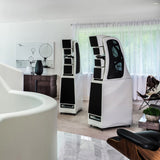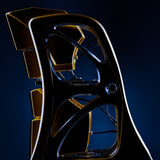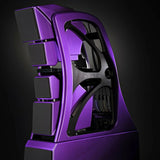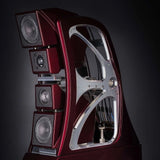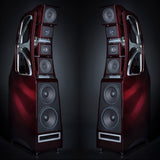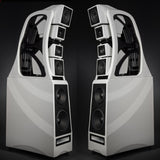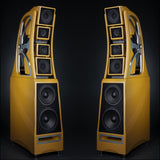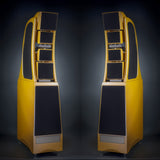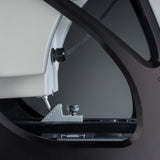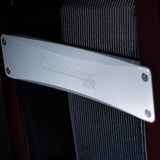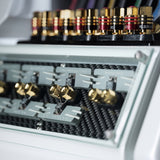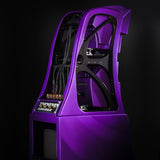Wilson Audio
Wilson Audio Chronosonic XVX Tower Loadspeaker
Chronosonic XVX
Some of the technology developed for the WAMM now resides in the Chronosonic XVX in a simpler form. More than in any other previous loudspeaker, Wilson introduced more technology, features, and manufacturing processes in the Chronosonic XVX.
Short of the WAMM itself, no other loudspeaker reproduces music as realistically or communicates the emotional power of the artists so eloquently.
Chronosonic XVX
The Intersection of Legacy and Technical Innovation
In late 2012, Dave Wilson began work on a new WAMM. His goal was a reference loudspeaker that would not merely be worthy of its namesake—Dave’s industry-changing WAMM from the early 80s—but would redefine the idea of what was possible in music reproduction. His goal was nothing short of a laboratory-grade loudspeaker that would pass a complex music signal through it with unprecedented accuracy. He knew the new model would challenge and test his company in new, potentially unforeseen ways. When he completed the design in 2016, Dave’s Magnum Opus did more to raise the bar than any previous loudspeaker.
The cost-no-object WAMM Master Chronosonic will always remain as Dave’s statement on music reproduction. From the outset, he understood and even stipulated that its production would be limited to a small number of pairs. For Daryl and all of the people at Wilson Audio, each WAMM is a symbolic reminder of Dave’s organizing passion—to categorically redefine the possibilities of music reproduction without any consideration of cost or practicality. Since he was a young child, Daryl has been immersed in this perfectionist culture. The central ideals of which played a significant role in molding his own uncompromising principles and standards.
It should come as no surprise that when the time was right, Daryl began design work for his own statement loudspeaker. In 2017, he knew it was time to push his and his engineering team’s skills, passion, and expertise to further limits and extremes—just as his father had with the WAMM. From this inchoate desire, he began formulating ideas for his new flagship loudspeaker. Ideas that launched an unprecedented wave of research and innovation within his design, engineering, and manufacturing teams. The fruits of this intensity have now culminated in a new category of loudspeaker, one that sits comfortably alongside his father’s masterpiece.
Wilson’s all-new Midrange: The Alnico QuadMagTM
The sound of un-amplified, live music has always driven the development of Wilson’s drivers. Just as Wilson’s current midrange driver finds its origins in the great concert halls of the world (chief among them the Musikverein in Vienna Austria), the new Wilson midrange driver’s development was fuelled by a passion for the authentic reproduction and emotional experience of live music.
Since early in his career, Dave Wilson was attracted to the natural beauty exhibited by many drivers using Alnico magnets. However, the existing crop of Alnico drivers fell well short of Wilson’s current proprietary midrange driver. His research surrounded this question: Could a driver combine all the virtues of Alnico magnets in a design that also offered the extreme resolution and dynamic expression of Wilson’s benchmark midrange driver?
The first Alnico prototype was co-developed by Dave (his last design project) and Vern Credille. From this platform of Dave’s original quest, Daryl and Vern continued experiments and research. The outgrowth of more than a year of research and development, Wilson’s QuadraMag driver is the answer to Dave’s original question.
Wilson’s new mid combines all the warmth and natural timbre of classic Alnico magnet formulation in a thoroughly modern design. The new QuadraMag midrange unit combines Alnico magnets in an entirely re-imagined “quadrature” geometry. The new midrange driver brings together unparalleled natural beauty, harmonic integrity, musicality, low distortion, and ultra-high resolution in a single design. It possesses a distinctive admixture of musical and technical virtues heretofore unrealized with any other previous design.
Myriad Details
The format of the flagship loudspeaker fits Daryl Wilson’s attitudes and convictions perfectly. He is extraordinarily compromise-adverse. Removing any constraints of price or practicality within the design equation felt liberating to Daryl. If Daryl had one advantage his father lacked, it was the WAMM itself. Some of the technology developed for the WAMM now resides in the Chronosonic XVX in a simpler form. More than in any other previous loudspeaker, Wilson introduced more technology, features, and manufacturing processes in the Chronosonic XVX.
Some examples: A new, fully integrated lighting system aids critical setup of the Chronosonic XVX’s time-domain array. When designing this portion of the upper Gantry, Daryl and Jarom turned to American lighting experts Coolfall, the world’s leading manufacturer of exotic custom flashlights. The custom system, designed in collaboration with Dave Livingston, owner of Coolfall, incorporates a precision solution for broad-gamut lighting during the critical adjustment of the complex time-domain mechanisms.
The tuning and protection resistors are located on an easily accessible portion of the rear cabinet. Each is mounted to a carbon fiber substrate. Changing resistors is a simple matter of removing a quick-release glass cover and removing the hardware from the heatsinks.
Driver Technology
Wilson Audio originally developed the ten and twelve-inch woofers appearing in Chronosonic XVX in conjunction with the WAMM project. From the outset, Vern Credille designed the two woofers from the ground up to complement each other. He individually optimized the drivers for speed, extension, low distortion, and authority. Chronosonic XVX’s woofers’ design and construction are the most advanced ever to be deployed in a Wilson loudspeaker. The volume-optimized, ultra-low resonance woofer enclosure provides the perfect platform for these state-of-the-art bass drivers. The sum total of all these elements work together to establish a new benchmark for bottom octave extension, musicality, and accuracy—bass performance in the same league as the WAMM.
As is true for the WAMM and the Alexx, the Chronosonic XVX utilizes two optimized drivers to cover the critical midrange. The aforementioned all new QuadraMag seven-inch driver handles the lower midrange, and a new four-inch driver handles the upper mids. The four-inch is a modified version of the same driver that first appeared in the WAMM Master Chronosonic. It covers the area up to the point where it seamlessly crosses over to the Convergent Synergy Tweeter.
The original Convergent Synergy was a benchmark of high-frequency beauty and ultra-high resolution. Since its introduction, Daryl has continued to refine and improve its performance. The Mk. 5 version works seamlessly with the XVX’s two-way midrange design. The rear-firing ambiance tweeter is also a Mk. 5 Convergent Synergy unit. For the first time, it is possible to adjust the rear-firing tweeter within a range of 0dB to minus 37dB, facilitating additional fine tuning for each installation.
Wilson-Made AudioCapX ® Capacitors
Wilson Audio recently moved its capacitor design and production in-house to control and improve quality and build upon its already industry-leading crossover-to-crossover consistency. Wilson has long been the leader for ultra-tight tolerances in its crossovers, combining the best components available with extremely meticulous execution and testing. Since its inception nearly a year ago, their new division resides at the pinnacle of innovative capacitor technology and empirical (music-centric) development. Within the Chronosonic XVX’s crossover, Wilson debuts the all new AudioCapX-WA (application-specific, bespoke versions of our AudioCapX). AudioCapX-WA capacitors advance the already state-of-the-art harmonic beauty and low noise floor within Wilson’s crossovers—and simplify the method for even tighter tolerances.
Cross-Load Flow Port (XLF)
As most audiophiles have experienced, various architectural details within a home affect the way a loudspeaker loads bass into the room. In homes featuring several large windows, for example, a loudspeaker with otherwise excellent bass performance can sound lean. Dave Wilson originally conceived of the Cross-Load Firing Port as an effective remedy for this real-world problem. An elegantly simple idea, the Cross-Load system allows the user to choose either a front or rear-firing port configuration. On the front of the XVX, below the woofers, a plate covers a plug for that (one-of- two) port. The port in this configuration is on the rear of the bass enclosure. In rooms where the rear-firing option would tend to overload the bass, it is merely a matter of removing the plate and port plug, switching those items to the rear, and attaching the low-turbulence trim to the front, moving the port exit to the front of the Chronosonic XVX.
Precision in Time
When developing the WAMM, the ultra-precise and minute adjustment of the modules in the time domain required more time and resources than any other single element. After more than a year of engineering time, Wilson completed the WAMM Master Chronosonic Micrometer system—a mechanism that facilitated the exact movement of the critical elements within the array. Like the WAMM, the goal for XVX’s time-domain accuracy was to approach the theoretical ideal, with adjustment increments in the two-millionths-of-a-second range with greater ease and simplicity.
The Chronosonic XVX time-domain array includes two Micrometer units—one for the upper QuadraMag driver and the Convergent Synergy tweeter submodule, the other for the second QuadraMag and the 4” midrange. In turn, each of those modules is individually adjustable within the array. This complex mechanism resides at the heart of the Chronosonic XVX’s exceptional time-domain accuracy and facilitates the loudspeaker’s optimization for nearly any sound-room and listening geometry. Only the WAMM matches the XVX’s real-world time-domain accuracy, which in most rooms deviates less than 5- millionths-of-a-second driver to driver.
The technology would be academic were it not for the extraordinary musical results it provides. Transient speed is increased as a direct result of waveforms that are properly aligned at the listening position. But perhaps more important is the lack of time-domain noise between the transients—the silence between the notes is revealed. It is this ability that most accounts for the XVX’s uncanny realism and emotional fluency.
In the end, all aspects of music are improved: harmonic expression, spatial resolution, micro detail, and spatial retrieval are greatly enhanced with time-domain accuracy.
MTMM Upper Array Geometry
The Chronosonic XVX Gantry is configured using an unusual MTMM (midrange, tweeter, midrange, midrange) arrangement. Wilson’s engineers further refined and perfected the proprietary two-way midrange system first developed in the WAMM and utilized in a simplified form in the ALEXX. The all new QuadraMag driver joins forces with a modified and enhanced version of the 4” midrange from the WAMM to form the lower section of the MTMM. A second QuadraMag midrange driver at the top of the Gantry flanks a Convergent Synergy Mk.5 tweeter, completing the MTMM geometry.
Construction of the Gantry of the XVX is accomplished via an open-architecture system constructed from X-Material reinforced, ultra-high-grade aluminium. The Gantry’s primary function is to provide an extremely rigid architecture for all the moving elements and modules that enable the system’s accurately adjustable time-domain. Special attention was paid to the triangulated cross bracing and the strategic use of X-Material composites in an effort to improve both rigidity and critical damping. The new scalloped finish on the aluminium elements is both beautiful and functional, acting as a diffuser to further minimize the XVX’s sonic signature within the room. A new magnet system secures the decorative Gantry grille covers, which enables quick and easy attachment or removal of the grille for service or listening.
Enclosure Materials
Most loudspeaker manufacturers are content with building enclosures from medium-density fibreboard (MDF)—a material originally used in the construction of tract-home sub floors. In contrast, Wilson has spent the last several decades researching and developing cutting-edge composites. It’s fair to suggest that Wilson’s success in addressing the deleterious effects of inadequate enclosure materials has started a marketing fad. It’s become de rigueur for high-end loudspeaker manufacturers to tout their newest material of choice. However, the clear majority of these market-driven efforts are intrinsically one-dimensional. Most loudspeaker designers typically focus on a single material, whether it is some pet grade of aluminium or the trend in carbon fiber. Materials research into the actual factors that improve musicality has been a key focus of Wilson’s ongoing efforts to push the envelope of loudspeaker performance for decades. Wilson’s materials-research facility is equipped with cutting-edge tools, including technology in the area of Laser Doppler Vibrometry. This aerospace testing tool allows Wilson’s engineers to observe and correct cabinet vibrations at the level of nanometers (one-billionth of a meter).
X-Material
The third generation of X-Material has its roots in its namesake: The X-1 Grand SLAMM. But this version of X is also a beneficiary of Wilson’s ongoing materials research. “X” is a material that at first seems paradoxical, but is in reality the result of decades of research into those areas of loudspeaker-enclosure science that truly contribute to musical veracity. No other material possesses its (seemingly contradictory) combination of extreme rigidity, monotonicity, modulus of elasticity, and intrinsic damping. X-Material is strategically utilized throughout the Chronosonic XVX’s enclosure, and is central to an unprecedented effort to reduce enclosure-born colorations to historical lows.
Wilson learned long ago that no enclosure material is ideal for all applications. This understanding—seemingly unique to Wilson Audio—has led to the development of other materials optimized in the areas for which X-Material is less than absolutely ideal.
S-Material
The research surrounding the Sasha W/P led to the development of S-Material, which is used in all of the midrange baffles. S is similar to X in its damping characteristics, but has been engineered for the unique demands of the musically critical midrange drivers.
V-Material
Wilson Audio’s newest composite technology—V-Material—is the newest product of Wilson Audio’s intensive and ongoing materials research. V- Material charts new territory with its unprecedented ability to dampen vibrations (it turns vibrations into heat with unparalleled rapidity). V was named for the Chronosonic X”V”X for which it was developed. V’s intrinsic silence makes it perfect for certain applications. In the Chronosonic XVX, it is positioned in the sub-plate of the Micrometer bed— the module transfer point in the Gantry superstructure—to optimize the upper modules’ coupling to the cabinet. It also forms the platform upon which the entire Gantry rests.
Standard Colors:
- Galaxy Gray
- GT Silver
- Quartz
- Carbon
- Medio Grigio
- Upgrade & Premium Pearl Colors on Request
Wilson Gloss™ Colors
Wilson Audio’s commitment to quality begins with the sound of their loudspeakers, but hardly ends there. The physical beauty and craftsmanship of Wilson products have long set the benchmark for the industry. Now, Wilson Audio is excited to introduce an updated and expanded range of colors, which include new Premium Pearl options.
WilsonGloss is a multi-stage process, from a proprietary protective gel coat layer through base color to the final series of clear coats—all followed by meticulous hand polishing. The final finish is unrivaled—even by the world’s greatest automobile manufacturers. Wilson Audo= have updated the selection of upgrade colors, which are available at a modest surcharge. Wilson Audio Premium WilsonGloss includes five new colors, each in a special pearl finish, which involve additional paint steps. WilsonGloss Premium is the ultimate expression of sophistication and beauty.
When combined with a choice of six grille-cloth colors, it’s easier than ever to individually design your Wilson loudspeaker so that it will complement your décor, or express your pride of ownership. Along with standard black grilles, you can alternatively specify Slate Grey, Parchment Grey, Mocha, Blanco White, or Le Mans Blue at no additional cost. With hundreds and hundreds of combinations available, you have the ability to design a Wilson speaker unique to your taste and décor.
For the ultimate in individual expression, Wilson Audio offers Custom Sample Match WilsonGloss finishes. Through your Wilson Dealer, provide them with your wall color, favourite automotive paint, or just about any color sample and we can, for an additional cost, create your loudspeakers in a one-of-a-kind WilsonGloss finish. This service includes on-site storage of custom paint for a period of five years. Contact your Dealer for program requirements and pricing.
| Enclosure Type Woofer | : | XLF Ported, Adjustable Rear or Front Firing |
| Enclosure Type Lower Midrange (7”) | : | Rear Vented |
| Enclosure Type Lower Midrange (4”) | : | Bottom Vented |
Enclosure Type Tweeter | : | Sealed |
| Woofers | : | One - 26.67 cm Hard Paper Pulp |
| : | One - 31.75 cm Hard Paper Pulp | |
| Midrange | : | Two - 17.78 cm Paper Pulp Composite |
| : | One - 10.16 cm Paper Pulp Composite | |
| Main Tweeter | : | One - 2.54 cm Doped Silk Fabric (Mk5 version) |
| Rear-firing Tweeter | : | One - 2.54 cm Doped Silk Fabric (Mk5 version) |
| Sensitivity | : | 92db @ 1W @ 1 meter @ 1kHz |
| Nominal Impedance | : | 4 Ω / minimum 1.6 Ω @ 326Hz |
| Minimum Amplified Power | : | 100 watts per channel |
| Frequency Response | : | 20Hz - 30kHz +/- 2dB Room Average Response [RAR] |
| Height | : | 187 cm w/o spikes |
| Width | : | 42 cm |
| Depth | : | 84 cm |
| System Weight per Channel | : | 310.71 Kg |














